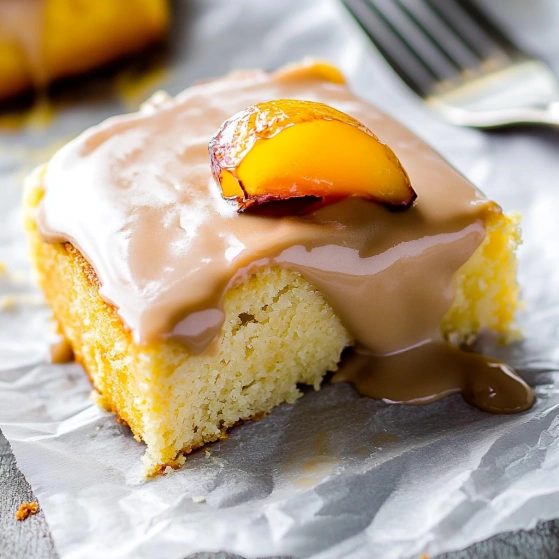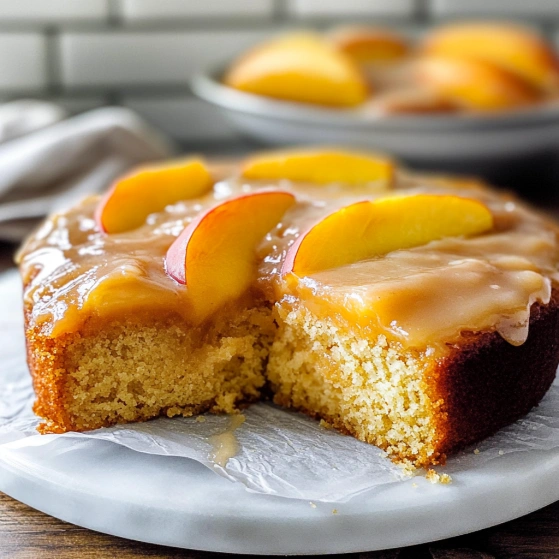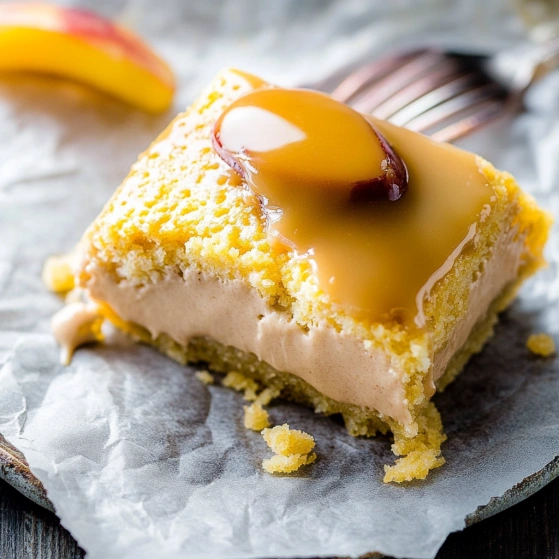 Pin it
Pin it
This Brown Sugar Peach Cake transforms ripe, juicy peaches into a tender, moist cake that perfectly balances sweetness with the natural fruit flavor. The combination of brown sugar and fresh peaches creates a caramelized depth that makes this cake irresistible whether served as a casual afternoon treat or an impressive dessert. The buttermilk adds tanginess while ensuring the crumb stays soft and delicate.
I've made this cake countless times during peach season, and it never fails to disappear within hours. Last summer, I brought it to a neighborhood potluck and came home with an empty plate and requests for the recipe.
Ingredients
- 170 grams Unsalted butter, softened: Provides richness and structure; ensure it's truly softened (not melted) for proper creaming with the sugars
- 200 grams Brown sugar, packed: Adds moisture and a caramel undertone; dark brown sugar offers deeper flavor, but light works well too
- 100 grams Granulated sugar: Creates the perfect balance of sweetness and helps with the cake's texture
- 3 Large eggs, at room temperature: Binds ingredients and adds structure; room temperature eggs incorporate much more evenly
- 2 teaspoons Pure vanilla extract: Enhances all the flavors; use real vanilla extract, not imitation, for best results
- 250 grams All-purpose flour: The foundation of the cake; measure by weight for accuracy
- 2 teaspoons Baking powder: Provides lift and airiness
- 0.5 teaspoons Baking soda: Works with the buttermilk to create tenderness
- 0.5 teaspoons Salt: Balances sweetness and enhances flavors
- 120 milliliters Buttermilk, at room temperature: Creates tenderness and moisture; if you don't have buttermilk, add 1 tablespoon lemon juice to regular milk
- 3 cups Fresh peaches, peeled and diced: The star ingredient; choose ripe but firm peaches for best texture
- 1 teaspoon Ground cinnamon: Complements the peaches with warm spice notes
- 2 tablespoons Powdered sugar (optional): Adds a decorative touch and slight sweetness to the finished cake
Step-by-Step Instructions
- 1. Prepare Your Space and Equipment:
- Set your oven to 175°C (350°F) and properly prepare your baking pan. Use a 9-inch round cake pan, greasing it thoroughly, particularly the sides. Line the bottom with a circle of parchment paper cut to fit, then grease the paper too. This double preparation ensures your cake releases perfectly after baking.
- 2. Create the Butter-Sugar Base:
- In a large mixing bowl, combine the softened butter with both brown and granulated sugars. Beat with an electric mixer for a full 3-4 minutes on medium speed. Don't rush this step – proper creaming incorporates air into the mixture, creating tiny pockets that expand during baking for a lighter texture. The mixture should notably change color, becoming paler and looking genuinely fluffy.
- 3. Add the Wet Ingredients:
- Add each egg one at a time, beating for about 30 seconds after each addition. This gradual incorporation prevents the batter from curdling and ensures each egg is fully integrated. After all eggs are incorporated, beat in the vanilla extract until just combined, being careful not to overmix.
- 4. Prepare the Dry Ingredients:
- In a separate bowl, thoroughly whisk together your flour, baking powder, baking soda, cinnamon, and salt. This even distribution prevents pockets of leavening agents or spice in your finished cake. Whisk for at least 30 seconds to ensure everything is well combined.
- 5. Combine Wet and Dry Mixtures:
- This critical step requires careful attention. Add about one-third of your dry ingredients to the butter mixture, mixing on low speed just until incorporated. Pour in half the buttermilk, mix again until just combined. Continue with another third of dry ingredients, followed by remaining buttermilk, and finish with the last portion of dry ingredients. Always end with dry ingredients for proper structure, and stop mixing the moment everything is incorporated.
- 6. Incorporate the Peaches:
- Using a rubber spatula, not the mixer, gently fold the diced peaches into the batter with a light hand. Use a scooping motion from the bottom of the bowl up and over, turning the bowl as you go, until the peaches are evenly distributed. This folding technique preserves the air you've worked to incorporate.
- 7. Transfer to Baking Pan:
- Pour the batter into your prepared pan, using your spatula to spread it evenly to the edges. Tap the pan gently on the counter once or twice to release any large air bubbles, then smooth the top for an even rise.
- 8. Bake to Perfection:
- Place the pan in the center of your preheated oven and bake for 40-45 minutes. Start checking at 40 minutes by inserting a toothpick into the center – it should come out clean or with a few moist crumbs, but no wet batter. The cake will have a beautiful golden-brown top and will have started to pull away slightly from the sides of the pan.
- 9. Initial Cooling Phase:
- Allow the cake to rest in the pan for exactly 10 minutes – not less (it's too fragile) and not more (it might stick). Place the pan on a cooling rack during this time. After 10 minutes, run a thin knife around the edge, then carefully invert the cake onto the rack, remove the parchment, and turn right-side-up to complete cooling.
- 10. Final Touches:
- Once completely cool (at least 1-2 hours), transfer the cake to a serving plate. Just before serving, use a fine-mesh sieve to lightly dust the top with powdered sugar, creating an elegant finish that highlights the cake's rustic beauty.
 Pin it
Pin it
I particularly love the peaches in this recipe. My grandmother had a peach tree in her backyard, and every summer we'd spend afternoons baking with freshly picked fruit. That first bite of warm peach cake always transports me back to her kitchen. Even my husband, who claims not to like fruit desserts, requests this cake specifically when peaches are in season.
Storage and Freshness Tips
This Brown Sugar Peach Cake stays remarkably fresh compared to other homemade cakes. Store it covered at room temperature for up to two days, maintaining its moisture and flavor profile perfectly. For longer storage, refrigerate in an airtight container for up to five days, though the texture will become slightly more dense. Always bring refrigerated slices to room temperature before serving to revive the cake's soft texture and allow the flavors to fully bloom.
Seasonal Variations Worth Trying
The versatile batter of this cake welcomes seasonal adaptations throughout the year. In autumn, substitute the peaches with diced apples and add a teaspoon of nutmeg for a warming harvest cake. Winter calls for frozen berries and a touch of lemon zest, creating a bright counterpoint to cold days. Spring brings opportunities for rhubarb or strawberries, while summer allows for nectarines, plums, or even a mixture of stone fruits. Each variation maintains the cake's moist crumb while offering a new flavor experience that reflects the season's best offerings.
 Pin it
Pin it
Serving Suggestions for Every Occasion
Transform this humble cake into different dining experiences with thoughtful accompaniments. For breakfast or brunch, serve slightly warm slices with a dollop of Greek yogurt and a drizzle of honey. As an afternoon treat, pair it with coffee or tea, allowing the cake to shine on its own. For dessert, elevate it with a scoop of vanilla bean ice cream or freshly whipped cream with a hint of bourbon. The cake also makes a beautiful centerpiece when topped with additional fresh peach slices and mint leaves just before bringing it to the table.
Frequently Asked Questions
- → Can I use canned peaches instead of fresh?
Yes, you can substitute fresh peaches with canned peaches. Be sure to drain them thoroughly and pat them dry to avoid adding excess moisture to the batter.
- → How can I ensure the cake is moist?
Using room-temperature ingredients, such as butter, eggs, and buttermilk, helps create a smooth batter and ensures even baking for a moist cake.
- → What can I use instead of buttermilk?
If you don’t have buttermilk, you can make a substitute by adding 1 tablespoon of lemon juice or vinegar to 120 milliliters of milk. Let it sit for 5 minutes before using.
- → How do I prevent the peaches from sinking in the batter?
To prevent sinking, lightly toss the diced peaches in a tablespoon of flour before folding them into the batter. This helps them stay evenly distributed.
- → How should I store the cake for freshness?
Store the cake in an airtight container at room temperature for up to two days, or refrigerate it for up to five days. Let it come to room temperature before serving.
